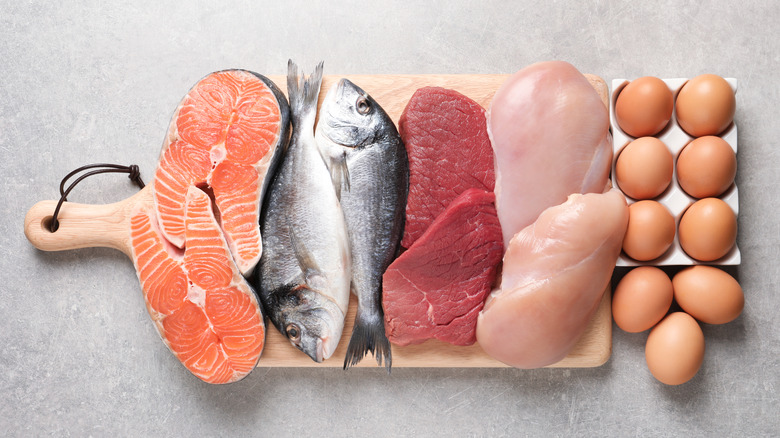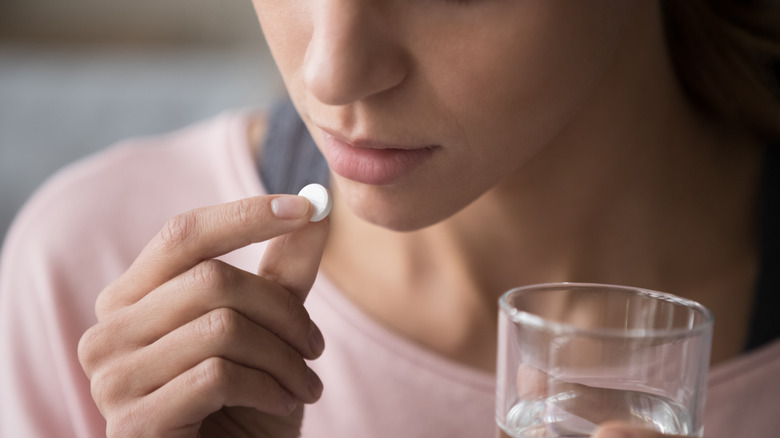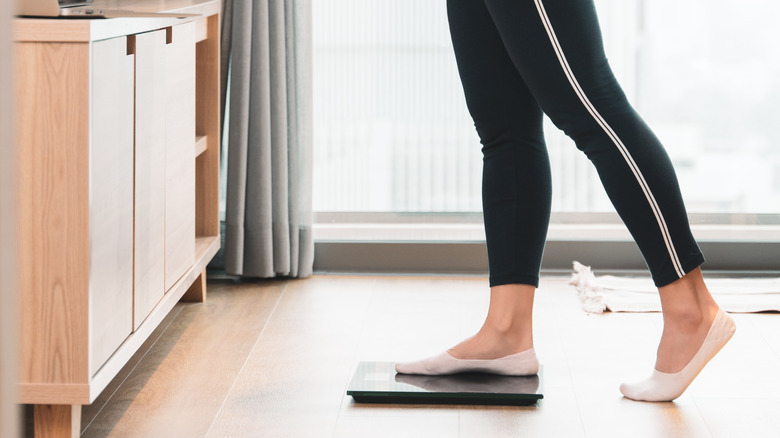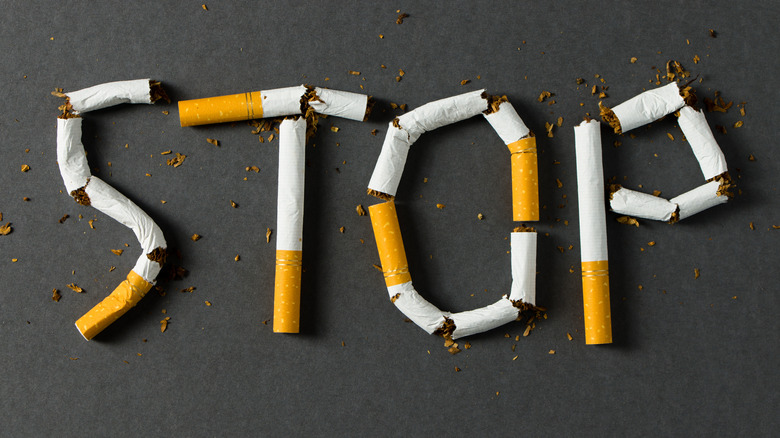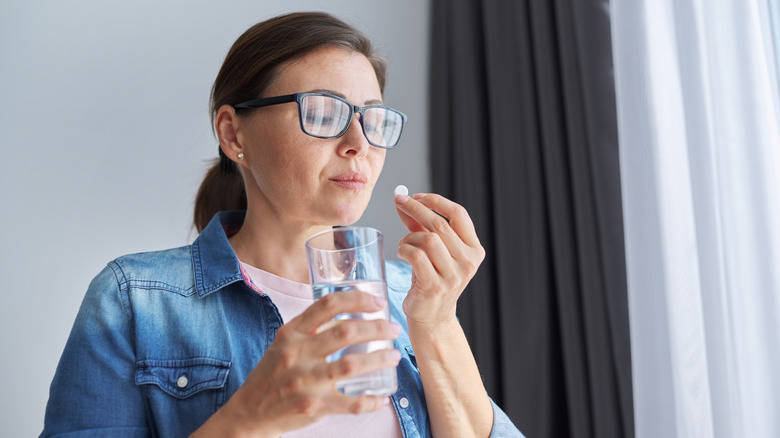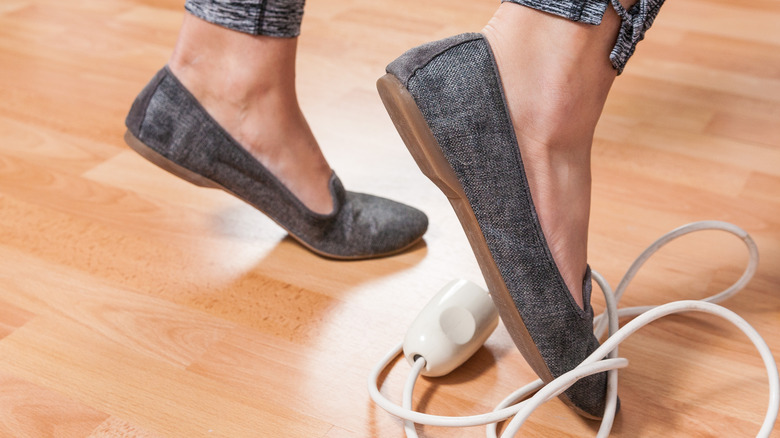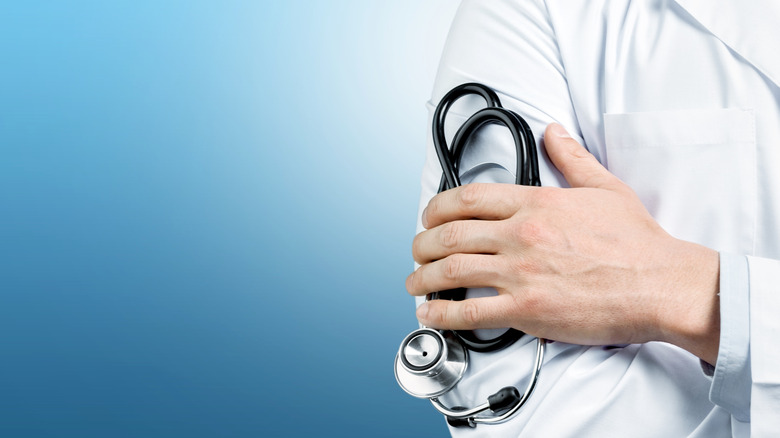13 Things You Can Do To Improve Your Bone Health
Strong bones are important for many reasons. Your bones are responsible for protecting internal organs, providing structure to your body, and storing essential nutrients (per the National Institutes of Health). When bones are weak, they break more easily. Broken bones can lead to a lot of pain and suffering, along with impacting quality of life. According to the Mayo Clinic, a common health condition called osteoporosis can cause bones to become weak and brittle, "Bone is living tissue that is constantly being broken down and replaced. Osteoporosis occurs when the creation of new bone doesn't keep up with the loss of old bone." In some cases, osteoporosis can leave those affected unable to walk. In extreme cases, it can even be deadly.
Although osteoporosis can affect people of all ages, some are more at risk than others. Because peak bone mass occurs in the late 20s, older people are generally more likely to have weakened bones. Also, reduced estrogen due to menopause places some women at even greater risk. Other risk factors include being white or Asian, having a small body frame, certain underlying diseases, and lifestyle influences — particularly those involving poor diet and inactivity.
While you can't control your age or genetics, there are many things you can do to strengthen your bones and prevent osteoporosis. To get started, we recommend focusing on proper nutrition, exercising regularly, and maintaining a healthy weight (via Everyday Health). Below, we discuss more things you can do to improve your bone health.
Consume plenty of calcium
You may already be aware of the link between calcium consumption and better bone health. Plus, calcium does more than just strengthen your bones; it also helps your muscles to move and your nerves to communicate between the brain and the rest of your body. According to the National Institutes of Health Office of Dietary Supplements, "Almost all calcium is stored in bones and teeth, where it supports their structure and hardness." But just how much does your body require in order to function properly? While individual calcium needs vary by life stage, adults aged 19-50 should aim to consume 1,000mg daily. Men aged 51-70 can continue on with this recommendation, whereas women in this age bracket should increase their intake to 1,200mg each day.
The Bone Health & Osteoporosis Foundation offers a handy guide to calcium-rich foods. Many dairy items top the list; an 8-ounce glass of milk contains 300mg of calcium, and a 6-ounce container of plain, low-fat yogurt offers 310mg. You can also find high levels of calcium in leafy green vegetables like kale and collard greens, in some types of seafood, and in fortified foods and drinks, including almond milk and orange juice. Although most health experts recommend getting nutrients directly from food, calcium supplementation may be beneficial if you are at risk for osteoporosis. Before taking any supplements, however, it is probably a good idea to discuss your plans with your doctor.
Add in some Vitamin D
To maintain strong bones, you're going to want to get plenty of vitamin D. Healthline reports that vitamin D is crucial for boosting bone health, along with improving immune function and providing protection from cancer, diabetes, high blood pressure, and other serious health conditions. Vitamin D also enables your body to absorb calcium (per the Bone Health and Osteoporosis Foundation). That said, it is also one of the most common vitamin deficiencies experienced around the world. In the United States, up to 42% of adults have low levels of vitamin D, with Black and Hispanic populations disproportionately affected.
Potential sources of vitamin D include sun exposure, food, and supplements. But these days, people are spending more and more time indoors, away from the sun. When they do go outside, they are more likely to use sunblock or wear protective clothing, impacting the amount of vitamin D received. Healthline reports that you should consume 800 IU (20 mcg) of vitamin D from foods daily, but you may want to aim closer to 1,000 IU (25 mg) if you don't spend much time outdoors. Healthy foods high in vitamin D include salmon, herring, sardines, cod liver oil, canned tuna, egg yolks, mushrooms, and fortified items like milk, orange juice, and cereal. If you suspect that you are not getting enough of this important nutrient, be sure to touch base with your doctor. They may suggest getting more sun, working with a registered dietician, or taking supplements.
Don't skimp on protein
If you consume enough calcium, eating more protein may benefit your bones. A 2014 research study published in Current Opinion in Clinical Nutrition and Metabolic Care suggested that greater protein intake can improve bone health in adults, but only when adequate calcium is consumed. While further research is needed to better understand this connection, we already know that eating enough protein offers a lot more health benefits than just strengthening your bones. Indeed, MedlinePlus touts proteins as "the building blocks of life", since adequate protein intake allows your body to repair cells, along with making new ones.
Verywell Fit offers a convenient calculator to determine your body's individual protein needs. After finding the number of calories you burn each day based on age, weight, height, and activity level, you can multiply this number by 10% to 35% to estimate a range of how many protein calories you should eat. If you find it easier to think in terms of protein grams, each gram of protein has four calories. In other words, simply divide your protein calorie goal by four. Good sources of protein include both animals and plants, including meats, seafood, eggs, soy, beans, legumes, nut butters, and some grains.
Participate in resistance training and weight-bearing exercise
According to The American Orthopaedic Society for Sports Medicine, exercise helps your body maintain its bone mass, along with reducing bone loss that occurs naturally with aging. All exercise is good, but when it comes to bone health, a combination of resistance training and weight-bearing exercises is best.
Resistance training, also known as strength training, can involve the use of weight machines, free weights, resistance bands, or body weight to place stress on the bones. This increases bone density and reduces the risk of osteoporosis (per the Mayo Clinic).
Examples of weight-bearing exercises include popular activities like walking, jogging, aerobics, dancing, household chores, and yard work. WebMD also recommends tai-chi, yoga, golf, and racquet sports. All of these activities involve muscles and gravity to place weight on the bones, making them stronger. Before starting any new exercise program, be sure to check in with your doctor. Most likely, they will applaud your efforts to improve your bone health.
Know the effects of your medications
You may be surprised to learn that some medications can negatively impact bone density. American Bone Health recommends reading the fine print on medication labels, "Some medicines can cause bone loss, some may increase your risk of a fall, and some may increase the chance of breaking a bone." Keep in mind that just because some medications place you at increased risk for bone issues doesn't mean you should automatically stop taking them. Often, the benefits of taking prescribed medications outweigh the risks. This is an individual decision that should involve open conversation between you and your medical provider.
Medications that impact bone density include high doses of cortisone-like pills (such as prednisone), high doses of thyroid medications, drugs that reduce estrogen or androgen levels, some diabetes medications, certain stomach medications, some antidepressants, blood thinners and anticoagulants, loop diuretics, and some anticonvulsant medications. If you are at high risk for poor bone health, make sure that you are getting enough calcium, vitamin D, protein, and exercise. You may also wish to ask your doctor about taking osteoporosis medication for preventative purposes.
Maintain a healthy body mass index (BMI)
Maintaining a healthy weight is another important thing you can do to improve your bone health. Eating disorders are a major risk factor for poor bone health. Among young women with anorexia nervosa, at least half will develop osteoporosis, according to 2015 research in Eating Disorders Review. Unfortunately, even after recovery, some of the damage may be irreversible. Treatment focuses on weight restoration, good nutrition, and monitored exercise.
Being underweight for any reason may place you at risk for bone problems. The Chicago Tribune reports, "Thin, small-boned women have an increased risk of osteoporosis, particularly if they are undernourished. Vitamin and mineral deficiencies contribute to hip fracture because they speed up bone loss, contribute to impaired coordination, and reduce the body's ability to protect itself during a fall." Achieving a healthy weight and eating well can help underweight individuals build stronger bones.
So if being underweight is bad for bones, does that mean being overweight is good? Researchers investigated the effects of body weight on bone mineral density during a 2012 study for the Annual Review of Nutrition. They not only concluded that obesity compromises bone quality, they also determined that caloric restriction can result in bone loss — meaning, not only can excess weight cause damage, the act of dieting may also be problematic. If you wish to lose excess weight and keep your bones strong, talk to your doctor. They may ask you to take protective measures, such as exercising regularly, eating a healthy diet, and using supplements.
Quit smoking
We all know that smoking is harmful. But did you know that it can impact your bones? According to Russel Stitzlein, M.D., of the UC Irvine School of Medicine's Department of Orthopaedic Surgery, smoking can weaken bones in a number of ways: "Smoking reduces the blood supply to the bones and to many other body tissues; the nicotine in cigarettes slows production of bone-producing cells, called osteoblasts; smoking decreases the body's absorption of calcium, which is necessary for vital cellular functions and bone health; smoking affects the balance of hormones, including estrogen, which is needed to build and maintain a strong skeleton in women and men" (via UC Irvine Health).
You can strengthen your bones, reduce your risk for many diseases, and improve your overall health by quitting smoking. The Centers for Disease Control and Prevention (CDC) points out that it's never too late, and provides helpful information on how to be successful. Resources include how to make a quit plan, what you need to know about quit-smoking medications, inspirational success stories, and where to find social support along your quitting journey.
Limit alcohol
While you may enjoy regularly knocking back a few drinks, we want you to know that your bones really don't appreciate the alcohol. The National Institute on Alcohol Abuse and Alcoholism states that chronic heavy drinking can compromise bone quality and increase the risk of osteoporosis. This is particularly true when heavy drinking occurs in adolescents and young adults. Perhaps even more concerning, research suggests that alcohol-induced bone damage can not be reversed, even if you decide to later abstain. Heavy and chronic drinking can lead to bone disease by contributing to decreased bone formation, increasing fractures, and preventing fractures from healing normally (per Verywell Mind).
When a bone fracture occurs, it would be wise to avoid alcohol entirely. In general, we suggest adhering to expert guidelines for the safe consumption of alcohol. For adults over 21, this means no more than two drinks per day for men, and no more than one drink a day for women (via the CDC). For individuals under age 21, drinking any alcohol at all is considered excessive alcohol use. Bottom line for bone health: The less you drink, the better.
Consider taking DHEA
A 2020 research abstract in Archives of Osteoporosis suggests a connection between the hormone dehydroepiandrosterone (DHEA) and increased bone mineral density. DHEA is produced naturally in the adrenal gland. It helps produce other hormones, including estrogen and testosterone (per the Mayo Clinic). A synthetic version is sold as a nutritional supplement.
On his YouTube channel, Dr. Eric Berg, D.C., discusses a number of things you can do to improve your bone health. For one, he recommends taking 10-15mg of DHEA if you have osteopenia, the precursor to osteoporosis. Science Daily also reports on the potential benefits of DHEA hormone replacement for bone health. Research suggests that older women taking a DHEA supplement, along with calcium and vitamin D, may experience improved spinal bone density. If you are interested in DHEA supplementation, discuss the pros and cons with your doctor before getting started. Since DHEA can increase estrogen and testosterone production in the body, taking it may also increase your risk of developing some types of cancer.
Mind your Vitamin K2 intake
Although Vitamin K is better known for its association with blood clotting, there appears to be a link between this essential nutrient and better bone health. According to American Bone Health, "Studies have shown that poor vitamin K intake is linked to low bone mass, osteoporosis, and fracture risk. Women who consumed less than 109mcg of vitamin K per day were found to be more likely to break a hip. Low vitamin K intake has also been linked to increased risk of hip fractures in men and women and to low bone density in women."
But before you rush out to purchase a bottle of vitamin K supplements, there are a few things you should know. First of all, vitamin K comes in two forms: vitamin K1 (typically found in leafy greens and cruciferous vegetables) and K2 (mostly produced in gut bacteria, but small amounts can be found in certain foods). Although both types may play a role in bone health, the link is stronger with Vitamin K2.
Similar to other supplements, vitamin K from food can benefit the body more than when taken in a supplement form (per WebMD). Foods containing vitamin K2 include grass-fed meats, dairy products, and some fermented foods. The Cleveland Clinic specifically suggests hard cheeses like gouda and swiss, blue cheese, chicken, pork, eggs, and natto (Japanese fermented soybeans).
Declutter your surroundings
One way to prevent fall-related injuries is to make sure your surroundings are as safe as possible. An estimated 8.9 million fractures worldwide can be attributed to osteoporosis, according to Healthline. This means one is happening somewhere about every three seconds — yikes. Women over 50 are most heavily affected, with one in three experiencing a fracture related to osteoporosis. For men over 50, the odds are one in five. The most common types that occur are vertebral, forearm, wrist, and hip fractures.
Everyday Health suggests a number of things that you can do to reduce your fall risk. These include: cleaning up clutter, repairing or removing trip hazards (including loose carpet and throw rugs), installing grab bars and rails, not wearing loose clothing, installing brighter light bulbs, avoiding stairs when possible, and generally moving around with greater caution. Healthline also recommends using nightlights, keeping a flashlight near your bed, and walking on grass instead of sidewalks that may be slippery from fallen leaves, rain, ice, or snow.
Take preventative medications
Along with making healthy lifestyle changes and doing your best to prevent falls, ask your doctor about taking preventative medications if you are at high risk for bone fractures. Per the Mayo Clinic, there are several possible options. One common class of osteoporosis medications are bisphosphonates. Depending on which type of bisphosphonate is prescribed, the medication may be taken as a weekly or monthly pill, or administered as a quarterly or annual infusion. Denosumab is another common osteoporosis medication that may be prescribed instead for people with reduced kidney function. It is administered as an injection every six months.
As with other medications, side effects can occur with osteoporosis medications. With bisphosphonate pills, these most often involve stomach upset or heartburn. The same side effects do not usually occur with bisphosphonate infusions; instead, mild flu-like symptoms may develop, but usually only after the first infusion.
Some women may benefit from taking estrogen to boost their bone health. However, because estrogen can increase the risk of blood clots, endometrial cancer, breast cancer, and possibly heart disease, this should be carefully considered.
Talk to your doctor
If you have concerns about your bone health, we encourage you to talk to your doctor. They can evaluate your health history and lifestyle influences to assess whether you are at high risk for osteoporosis. Then, they may order a bone scan to investigate the current state of your bones and determine whether treatment is necessary. Johns Hopkins Medicine defines a bone scan as a nuclear radiology procedure involving the injection of a very small amount of radionuclide (a nuclear substance) into the body. The radionuclide then emits gamma ray radiation, which can be detected by the bone scanner to form pictures of the bones.
Once your risk assessment and bone scan is complete, your doctor may be in a better position to make recommendations. They will likely suggest a number of things you can do to improve your bone health, including dietary changes, more exercise, and taking prescribed supplements or medications. To get the most out of your doctor visits, the National Institutes of Health suggests writing down questions or concerns beforehand, bringing along a companion to appointments, and taking detailed notes. You should also learn how to access your medical records online, since this can help you keep track of medications and test results, review treatment plans, and even schedule future appointments.




